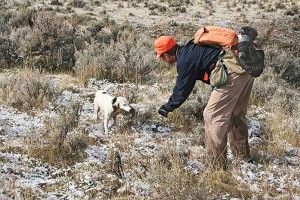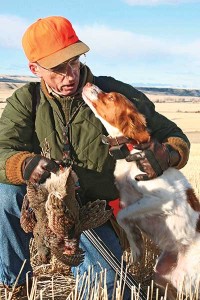 I'd spent months combing the coulees and thick, grassy draws but was having little luck finding the Huns my spaniel and I were searching for.
I'd spent months combing the coulees and thick, grassy draws but was having little luck finding the Huns my spaniel and I were searching for.
I had a lot riding on these birds, pulling up stakes in Colorado and moving to Montana largely on the basis of the state's bird hunting, Huns in particular. We were hunting good habitat, having cut my teeth on southern Iowa quail — when there were quail in southern Iowa — and these draws, choked with grass and snowberries, were essentially the same type I'd found quail in 20 years earlier.
Wheat stubble stretched to the horizons, providing an endless source of food. But as hard as my little spaniel, Poke, worked, it was a rare day when he produced a covey. Elsewhere in the state, I'd done considerably better on sharptails and pheasants.
I finished the season with a handful of birds in the freezer; far better than my Colorado days, but disappointing nonetheless. The following spring, I bought a pint-sized Brittany named Fancy. It was the best $200 I ever spent. That season was a revelation. Fancy, who was probably eight or nine months old, proceeded to teach me about Hungarian partridge.
She found one covey after the next in the sagebrush and sparsely-grassed hillsides, not the cover I had been hunting.
It didn't make any sense but I couldn't argue with my little dog, who probably found more birds in the first couple weeks than my spaniel had the previous season. If ever there was a bird meant to be hunted by pointing dogs, it is the Hungarian partridge.
Most gamebirds run, and Huns are no exception. There are days when your dog won't be able to get close to them. But there are also days when they hold quite well, far better than most of the other birds I've hunted across the country, although they'll almost never sit for a dog that pushes them too hard. In that respect, they're a lot like ruffed grouse. They'll play your game, and give you and your dog a rollicking good time of it, but they choose the rules.
It's Not Easy
Huns are widely distributed across eastern Washington and Oregon, across Montana and the Dakotas and into Minnesota. At one time, there were enough of them in southern Wisconsin to provide decent sport, but those birds are apparently gone. Still, there are far more coveys of Huns out there than there are Hun hunters.
I've spent the last 27 seasons trying to figure out why. Here is a bird that lives on both public and private land, generally holds well to a point, is often hunted in spectacular country, and is great table fare. What was I missing? The conclusion I've arrived at says far more about bird hunters than the birds themselves. Huns aren't easy.
Hun hunting is a sport for walkers, designed for people who don't mind putting in a half-dozen miles or more behind a hard-working pointing dog in what can be some pretty rough country. Furthermore, many people assume, or have been told, you need big-running dogs. I was told the same thing and for many years preached the gospel of wide-ranging pointers, but I no longer believe that.
Leaving aside intangibles like style and speed, any close- to moderate-ranging pointer can become a sufficient prairie Hun dog. Griffons, English pointers, Brittanys, English setters, shorthairs€¦I've seen good dogs among all these breeds and more. It isn't necessary to have a dog that runs to the horizon; and even if it were, is that really what you want?
Instead, you want a dog that hunts with you, that checks in periodically and is close enough when he does find birds that you have a reasonably good chance of getting there before they go up. For me, the ideal dog has a roughly 200-yard cast, giving you the chance to watch the dog work and point birds.
I've hunted over dozens of Brittanys that typically work at 150 yards or less, often considerably less, and if their relatively close range is a disadvantage it's not obvious to me. Is there such a thing as too close? Sure. Any pointing dog that hunts within flushing dog-range is too close. Beyond that, you're golden.
Remain Steady
For most gamebirds, all you really need to train your dog to do is to come back when you call him and stop dead in his tracks when you tell him to whoa. But I'd like to humbly suggest one other requirement for any prairie pointer: steadiness. Huns live in wide open country, and the temptation to chase birds will be hard for some to resist. Steadiness training solves that problem.
Although there can be good populations of Huns in open grasslands, I typically hunt them in or around wheat and barley fields surrounded by grassy hills, allowing my dogs to cast into the grain and back into the grass again. It's a good strategy and one that I still use.
 Lately though, on the advice of a friend, I began spending a little more time in the wheat — some of the fields I hunt are a half-mile across — and I began finding Huns right out in the middle of them. Some coveys move into the wheat first thing in the morning and just keep moving, walking and feeding all day long. On other days, they stick to the more traditional edges. If you don't find them in one location, try the other.
Lately though, on the advice of a friend, I began spending a little more time in the wheat — some of the fields I hunt are a half-mile across — and I began finding Huns right out in the middle of them. Some coveys move into the wheat first thing in the morning and just keep moving, walking and feeding all day long. On other days, they stick to the more traditional edges. If you don't find them in one location, try the other.
And above all else, pay attention to what your dog is telling you. A couple seasons ago, my friend Chuck and I were combing a hillside covered with junipers, which I normally avoid, since I almost never find Huns near them. Then, suddenly, my setter and his Brittany went on point, and when Chuck walked up to investigate, he saw Hun tracks in the snow. I doubted — out loud — he was seeing actual Hun tracks, and about that time a covey rose. I still get to hear about that one every time we sit down for a beer.
Hun hunting is an aerobic sport for hunters, not shooters. Make sure you (and the dog) are ready to cover miles of difficult terrain, and you may find that it's one of the better venues for pointers.






